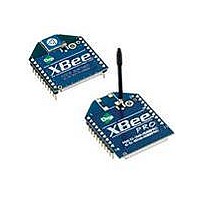XBP09-DPSIT-156 Digi International, XBP09-DPSIT-156 Datasheet - Page 13

XBP09-DPSIT-156
Manufacturer Part Number
XBP09-DPSIT-156
Description
MODULE XBEE PRO W/RPSMA
Manufacturer
Digi International
Series
XBEE-PRO™r
Specifications of XBP09-DPSIT-156
Frequency
902MHz ~ 928MHz
Data Rate - Maximum
156kbps
Modulation Or Protocol
FHSS
Applications
ISM
Power - Output
17dBm (50mW)
Sensitivity
-100dBm
Voltage - Supply
3 V ~ 3.6 V
Current - Receiving
80mA
Current - Transmitting
210mA
Data Interface
PCB, Through Hole
Antenna Connector
RP-SMA
Operating Temperature
-40°C ~ 85°C
Package / Case
Module
Lead Free Status / RoHS Status
Lead free / RoHS Compliant
Memory Size
-
Lead Free Status / Rohs Status
Lead free / RoHS Compliant
Other names
602-1169
XBee‐PRO® 900 RF Modules
Idle Mode
Transmit Mode
A Comparison of Transparent and API Operation
The following table compares the advantages of transparent and API modes of operation:
As a general rule of thumb, API firmware is recommended when a device:
If the above conditions do not apply (i.e. a sensor node, router, or a simple application), then AT
firmware might be suitable. It is acceptable to use a mixture of devices running API and AT
firmware in a network.
To implement API operations, refer to the API Operation chapter 6.Modes of Operation
When not receiving or transmitting data, the RF module is in Idle Mode. During Idle Mode, the RF
module is checking for valid RF data. The module shifts into the other modes of operation under
the following conditions:
When serial data is received and is ready for packetization, the RF module will exit Idle Mode and
attempt to transmit the data. The destination address determines which node(s) will receive the
data.
For mesh firmware, if a route is not known, route discovery will take place for the purpose of
establishing a route to the destination node. If a module with a matching network address is not
discovered, the packet is discarded. The data will be transmitted once a route is established. Route
discovery will be attempted only once per packet.
Simple Interface
Easy to support
Easy to manage data
transmissions to multiple
destinations
Received data frames
indicate the sender's
address
Advanced addressing
support
Advanced networking
diagnostics
Remote Configuration
© 2009 Digi International, Inc.
• sends RF data to multiple destinations
• sends remote configuration commands to manage devices in the network
• receives IO samples from remote devices
• receives RF data packets from multiple devices, and the application needs to know which
• Transmit Mode (Serial data in the serial receive buffer is ready to be packetized)
• Receive Mode (Valid RF data is received through the antenna)
• Command Mode (Command Mode Sequence is issued)
• Sleep Mode (A device is configured for sleep)
device sent which packet.
All received serial data is transmitted unless the module is in command mode.
Transmitting RF data to multiple remotes only requires changing the address in the API frame. This
process is much faster than in transparent operation where the application must enter AT command
mode, change the address, exit command mode, and then transmit data.
Each API transmission can return a transmit status frame indicating the success or reason for
failure.
All received RF data API frames indicate the source address.
API transmit and receive frames can expose addressing fields including source and destination
endpoints, cluster ID and profile ID.
API frames can provide indication of IO samples from remote devices, and node identification
messages.
Set / read configuration commands can be sent to remote devices to configure them as needed
using the API.
It is easier for an application to support transparent operation and command mode
Transparent Operation Features
API Operation Features
13














